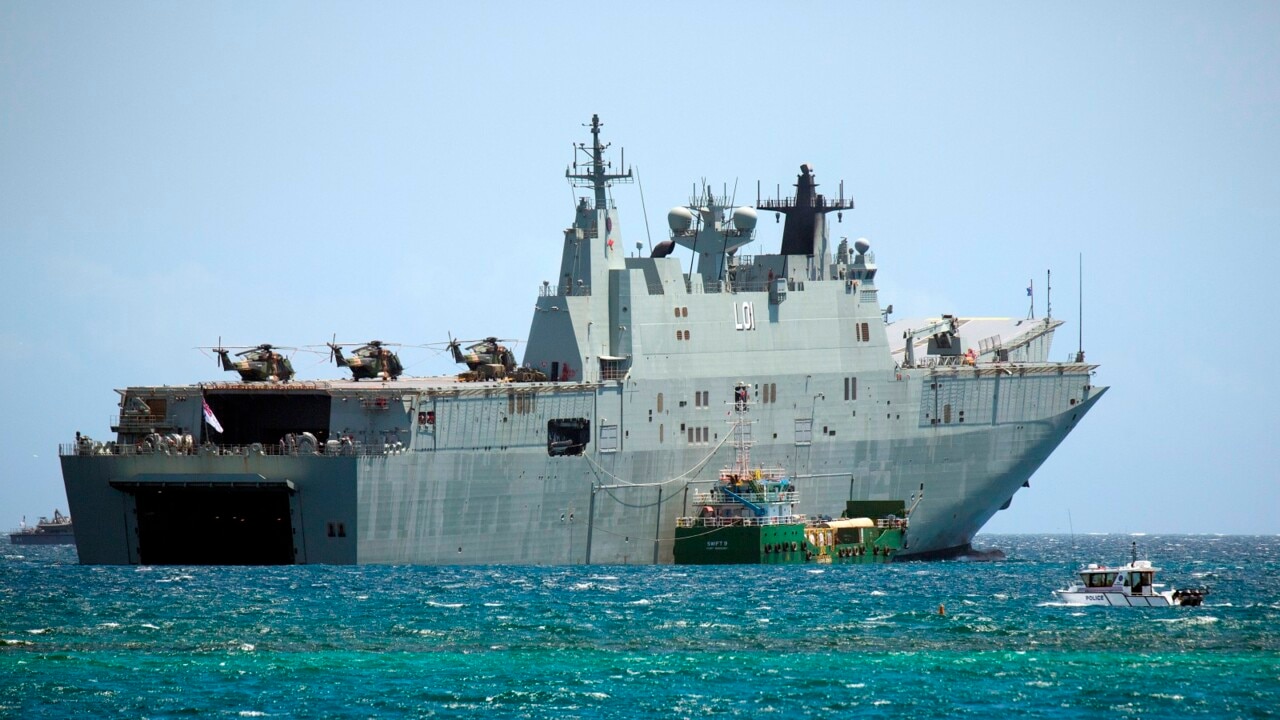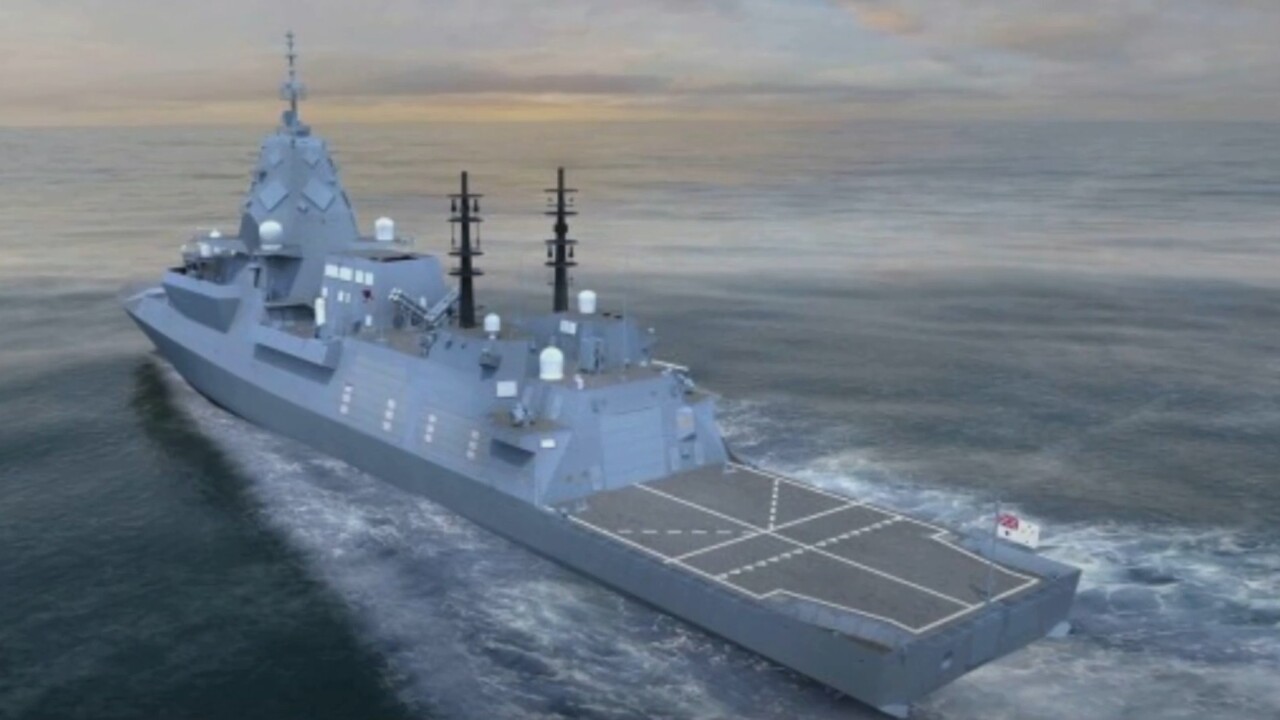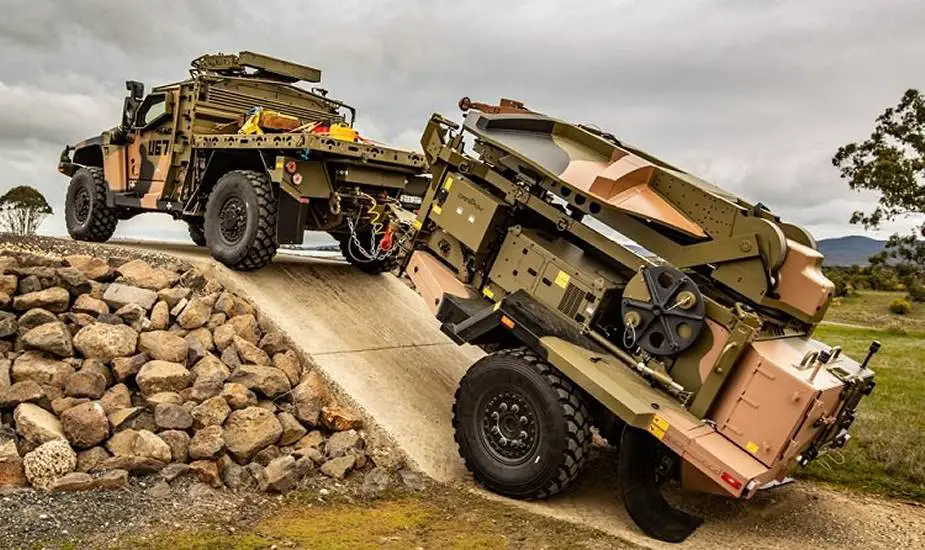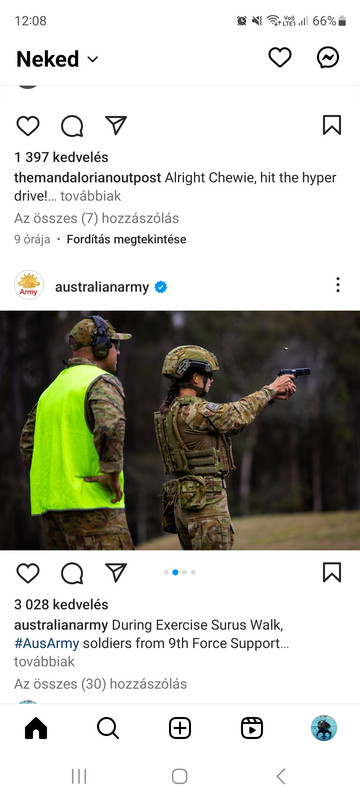Ráadásul a kovid is eszi őket.Egy hatalmas áramkimaradás leállította a HMAS Adelaide-et a tongai humanitárius küldetése során.
A hajó a teljes áramkimaradás miatt egy ideig „sodorodot”, és továbbra is külső kommunikációs problémák jelentkeznek, annak ellenére, hogy az áramellátás most helyreállt.
A hírek szerint a hajó legénységének nagy része a „fedélzet felett” alszik az áramellátási problémák miatt.
A HMAS Adelaide az Ausztrál Haditengerészet legnagyobb hadihajója, és a fedélzeten lévő legénység napokig tartó vészhelyzeti munkákat végez Tongában a múlt havi vulkánkitörés és szökőár után.

HMAS Adelaide left ‘stranded’ by total power outage
A massive electrical power failure has halted the HMAS Adelaide during its humanitarian mission to Tonga. The ship was left “stranded” for a period of time due to the total power failure and is still experiencing external communications issues despite power now being restored. Most of the...www.news.com.au
Ausztrália fegyveres ereje és haderőfejlesztése
- Téma indítója joker
- Indítva
-
- Címkék
- ausztrália
-
Ha nem vagy kibékülve az alapértelmezettnek beállított sötét sablonnal, akkor a korábbi ígéretnek megfelelően bármikor átválthatsz a korábbi világos színekkel dolgozó kinézetre.
Ehhez görgess a lap aljára és a baloldalon keresd a HTKA Dark feliratú gombot. Kattints rá, majd a megnyíló ablakban válaszd a HTKA Light lehetőséget. Választásod a böngésződ elmenti cookie-ba, így amikor legközelebb érkezel ezt a műveletsort nem kell megismételned. -
Az elmúlt időszak tapasztalatai alapján házirendet kapott a topic.
Ezen témában - a fórumon rendhagyó módon - az oldal üzemeltetője saját álláspontja, meggyőződése alapján nem enged bizonyos véleményeket, mivel meglátása szerint az káros a járványhelyzet enyhítését célzó törekvésekre.
Kérünk, hogy a vírus veszélyességét kétségbe vonó, oltásellenes véleményed más platformon fejtsd ki. Nálunk ennek nincs helye. Az ilyen hozzászólásokért 1 alkalommal figyelmeztetés jár, majd folytatása esetén a témáról letiltás. Arra is kérünk, hogy a fórum más témáiba ne vigyétek át, mert azért viszont már a fórum egészéről letiltás járhat hosszabb-rövidebb időre.
-
Az elmúlt időszak tapasztalatai alapján frissített házirendet kapott a topic.
--- VÁLTOZÁS A MODERÁLÁSBAN ---
A források, hírek preferáltak. Azoknak, akik veszik a fáradságot és összegyűjtik ezeket a főként harcokkal, a háború jelenlegi állásával és haditechnika szempontjából érdekes híreket, (mindegy milyen oldali) forrásokkal alátámasztják és bonuszként legalább a címet egy google fordítóba berakják, azoknak ismételten köszönjük az áldozatos munkáját és további kitartást kívánunk nekik!
Ami nem a topik témájába vág vagy akár csak erősebb hangnemben is kerül megfogalmazásra, az valamilyen formában szankcionálva lesz
Minden olyan hozzászólásért ami nem hír, vagy szorosan a konfliktushoz kapcsolódó vélemény / elemzés azért instant 3 nap topic letiltás jár. Aki pedig ezzel trükközne és folytatná másik topicban annak 2 hónap fórum ban a jussa.
You are using an out of date browser. It may not display this or other websites correctly.
You should upgrade or use an alternative browser.
You should upgrade or use an alternative browser.
Majd a tongaiak kimentik őket evezőshajóikkal...Egy hatalmas áramkimaradás leállította a HMAS Adelaide-et a tongai humanitárius küldetése során.
A hajó a teljes áramkimaradás miatt egy ideig „sodorodot”, és továbbra is külső kommunikációs problémák jelentkeznek, annak ellenére, hogy az áramellátás most helyreállt.
A hírek szerint a hajó legénységének nagy része a „fedélzet felett” alszik az áramellátási problémák miatt.
A HMAS Adelaide az Ausztrál Haditengerészet legnagyobb hadihajója, és a fedélzeten lévő legénység napokig tartó vészhelyzeti munkákat végez Tongában a múlt havi vulkánkitörés és szökőár után.

HMAS Adelaide left ‘stranded’ by total power outage
A massive electrical power failure has halted the HMAS Adelaide during its humanitarian mission to Tonga. The ship was left “stranded” for a period of time due to the total power failure and is still experiencing external communications issues despite power now being restored. Most of the...www.news.com.au

Classified report reveals new fleet of warships ‘slower and unsafe’
A classified Defence Department report has revealed a new fleet of warships - designed for the Australian government - are slower and less safe than intended. The government has signed a $45 billion contract for nine Hunter-class frigates, which are set to replace the current Anzac-class fleet...
Egy hatalmas áramkimaradás leállította a HMAS Adelaide-et a tongai humanitárius küldetése során.
A hajó a teljes áramkimaradás miatt egy ideig „sodorodot”, és továbbra is külső kommunikációs problémák jelentkeznek, annak ellenére, hogy az áramellátás most helyreállt.
A hírek szerint a hajó legénységének nagy része a „fedélzet felett” alszik az áramellátási problémák miatt.
A HMAS Adelaide az Ausztrál Haditengerészet legnagyobb hadihajója, és a fedélzeten lévő legénység napokig tartó vészhelyzeti munkákat végez Tongában a múlt havi vulkánkitörés és szökőár után.

HMAS Adelaide left ‘stranded’ by total power outage
A massive electrical power failure has halted the HMAS Adelaide during its humanitarian mission to Tonga. The ship was left “stranded” for a period of time due to the total power failure and is still experiencing external communications issues despite power now being restored. Most of the...www.news.com.au

Van olyan hipotézis ugye, hogy a tongai giga-vulkánkitörés nem természetes eredetű volt! (Gondoltam megemlítem...
 )
)This page has moved!
You will be redirected in 5 seconds... If you are not automatically re-directed, click here. <meta http-equiv=

HMAS Adelaide (L01) - Wikipedia
Land 400 Phase 3... Legyen meg itt is:
Hawkes (janes) szerint holnap megtörténik az ausztrál győztes kihírdetése.

Australia to build unmanned subs amid tensions with China | Libertarian Hub
Three prototype vessels will be built over the next three years, the country’s defense minister has said Australia is seeking to build “a new autonomous rob ...
libertarianhub.com
Lynx is, Redback is, Bundeswehr is, pletyó is... úgyhogy inkább iderakom.
It was meant to be one of the most consequential Defence investments ever – the announcement of the winner of the $25bn competition for 400 new generation tracked infantry Fighting Vehicles for the army.
The choice between South Korea’s Hanwha and Germany’s Rheinmetall was widely expected in late March after a meeting of the National Security Committee of cabinet, but days and then weeks passed with nothing further being heard. To the surprise of almost everyone, the government now says that a decision will be made in September.
The army had completed a very thorough two-year test and trials program involving three vehicles from each bidder in November last year. These were held at various locations across Australia examining issues of mobility, reliability, firepower and survivability – the latter done by measuring the effects of explosive charges near and under a Hanwha Redback and Rheinmetall Lynx.
Defence is believed to have completed their paperwork bringing together elements of price, risk and local content early in the new year.
Understanding what has happened is not easy, with the notoriously opaque department banning companies from discussing the process and the government similarly uncommunicative. However, there is anecdotal evidence suggesting that things have been derailed at a political level.
Despite official denials, it seems that there have been some differences between the army – which liked the Redback – and the procurement arm that saw the Lynx as a lower risk solution.
At a distance, both vehicles look roughly similar – but as usual the difference is in the detail. The Redback uses rubber-steel mesh tracks; the Lynx has a more conventional segmented steel plate arrangement. The Redback uses a U.S. Bushmaster 30mm chain gun as its main armament; the Lynx has a proprietary Mauser gas-operated cannon – and so on. Both solutions are technically acceptable.
The Canberra rumours were that all of these internal differences had finally been resolved in favour of the Redback.
It is then suggested that the government of Germany – whether or not it was aware of the exact situation – bypassed Defence and made an unsolicited offer at cabinet level that it would also purchase a similar number of Lynx vehicles. These would come from the Australian production line, which would be established in the politically sensitive area of Ipswich in southeast Queensland.
If accepted, this would be a massive boost in an already large program, holding out the prospect of even more jobs, export opportunities and increased revenue.
At about the same time, the South Korean government communicated semi-officially that it was already in the process of purchasing an initial batch of between 30 and 50 Redback vehicles for their army – which is about 10 times larger than its German counterpart. A full Redback order could be as large as 2000 vehicles – all coming from the electorally sensitive Geelong area.
Parts of this story can be verified. The South Korean military is in the process of purchasing some Redbacks. The German Army is interested in buying Lynx vehicles following a confirmed initial sale of them to Hungary.
However, many details are still obscure and might never see the light of day because they relate to whether Australia should be buying military hardware for its excellence or because of broader economic benefits.
If it seems unlikely that the industrial powerhouses of South Korea and Germany would purchase armoured vehicles built in Australia rather than from their own production lines, think again.
There is a trend in the Western world for countries to move away from single suppliers to multiple sources among allies of critical equipment. This has been caused in part by Covid disrupting well established industrial arrangements – plus conflicts such as Ukraine where the factories of a single country are no longer capable of meeting the huge demands for material that happen after only a few days of high intensity conflict.
The intense fighting in Ukraine might also have contributed to the delay in the Australian decision in another way.
Television screens have been dominated for months by images of the smouldering wrecks of hundreds – if not thousands – of Russian armoured vehicles. These have been destroyed in huge numbers by relatively cheap anti-tank guided munitions, sometimes fired by individual Ukrainian soldiers with minimal training.
The Russian losses have been horrendous and due to social media, the vulnerabilities of conventional – if poorly handled – armoured forces are on display for everyone to see.
Putting these things together, an announcement that the government was committing $25bn on armoured vehicles might have looked like a waste of money rather than a demonstration of strength.
Infantry Fighting Vehicle decision mystery
It was meant to be one of the most consequential Defence investments ever – the announcement of the winner of the $25bn competition for 400 new generation tracked infantry Fighting Vehicles for the army.
The choice between South Korea’s Hanwha and Germany’s Rheinmetall was widely expected in late March after a meeting of the National Security Committee of cabinet, but days and then weeks passed with nothing further being heard. To the surprise of almost everyone, the government now says that a decision will be made in September.
The army had completed a very thorough two-year test and trials program involving three vehicles from each bidder in November last year. These were held at various locations across Australia examining issues of mobility, reliability, firepower and survivability – the latter done by measuring the effects of explosive charges near and under a Hanwha Redback and Rheinmetall Lynx.
Defence is believed to have completed their paperwork bringing together elements of price, risk and local content early in the new year.
Understanding what has happened is not easy, with the notoriously opaque department banning companies from discussing the process and the government similarly uncommunicative. However, there is anecdotal evidence suggesting that things have been derailed at a political level.
Despite official denials, it seems that there have been some differences between the army – which liked the Redback – and the procurement arm that saw the Lynx as a lower risk solution.
At a distance, both vehicles look roughly similar – but as usual the difference is in the detail. The Redback uses rubber-steel mesh tracks; the Lynx has a more conventional segmented steel plate arrangement. The Redback uses a U.S. Bushmaster 30mm chain gun as its main armament; the Lynx has a proprietary Mauser gas-operated cannon – and so on. Both solutions are technically acceptable.
The Canberra rumours were that all of these internal differences had finally been resolved in favour of the Redback.
It is then suggested that the government of Germany – whether or not it was aware of the exact situation – bypassed Defence and made an unsolicited offer at cabinet level that it would also purchase a similar number of Lynx vehicles. These would come from the Australian production line, which would be established in the politically sensitive area of Ipswich in southeast Queensland.
If accepted, this would be a massive boost in an already large program, holding out the prospect of even more jobs, export opportunities and increased revenue.
At about the same time, the South Korean government communicated semi-officially that it was already in the process of purchasing an initial batch of between 30 and 50 Redback vehicles for their army – which is about 10 times larger than its German counterpart. A full Redback order could be as large as 2000 vehicles – all coming from the electorally sensitive Geelong area.
Parts of this story can be verified. The South Korean military is in the process of purchasing some Redbacks. The German Army is interested in buying Lynx vehicles following a confirmed initial sale of them to Hungary.
However, many details are still obscure and might never see the light of day because they relate to whether Australia should be buying military hardware for its excellence or because of broader economic benefits.
If it seems unlikely that the industrial powerhouses of South Korea and Germany would purchase armoured vehicles built in Australia rather than from their own production lines, think again.
There is a trend in the Western world for countries to move away from single suppliers to multiple sources among allies of critical equipment. This has been caused in part by Covid disrupting well established industrial arrangements – plus conflicts such as Ukraine where the factories of a single country are no longer capable of meeting the huge demands for material that happen after only a few days of high intensity conflict.
The intense fighting in Ukraine might also have contributed to the delay in the Australian decision in another way.
Television screens have been dominated for months by images of the smouldering wrecks of hundreds – if not thousands – of Russian armoured vehicles. These have been destroyed in huge numbers by relatively cheap anti-tank guided munitions, sometimes fired by individual Ukrainian soldiers with minimal training.
The Russian losses have been horrendous and due to social media, the vulnerabilities of conventional – if poorly handled – armoured forces are on display for everyone to see.
Putting these things together, an announcement that the government was committing $25bn on armoured vehicles might have looked like a waste of money rather than a demonstration of strength.
Valami meghallgatáson az aussi szenátornő azt kérdezi a szerencsétlen admirálistól, hogy a tengeralattjáróik tudnak-e 20 percig a víz alatt maradni?.
Csóri admirális azt válaszolja, hogy a pontos érték hadititok.

Csóri admirális azt válaszolja, hogy a pontos érték hadititok.
Army Recognition: Australian army gest Boeing Defence Australia Currawong battle space communication systems

..."Project Currawong is an Australian defence industry success story. From ground-up electronics to mechanical and software development, all components of the system are designed and developed in Australia with 235+ people directly employed on the project, along with 200+ local enterprises. Project Currawong is delivered under LAND 2072 Phase 2B. In fact, the AUD875 million program was formally known as Land 2072 Phase 2B when it began. Seven years later, it’s known as JP 2072 Phase 5B, Colin Clark writes."...

..."Project Currawong is an Australian defence industry success story. From ground-up electronics to mechanical and software development, all components of the system are designed and developed in Australia with 235+ people directly employed on the project, along with 200+ local enterprises. Project Currawong is delivered under LAND 2072 Phase 2B. In fact, the AUD875 million program was formally known as Land 2072 Phase 2B when it began. Seven years later, it’s known as JP 2072 Phase 5B, Colin Clark writes."...

Oroszok Az Igazság Oldalán
USA bejelentette a hadsereg és a haditengerészet fokozott jelenlétét Ausztráliában Az Egyesült Államok növelni fogja erőinek rotációs jelenlétét Ausztráliában, ideértve a bombázókat és a vadászgépeket – jelentette ki Lloyd Austin amerikai védelmi miniszter kedden a két szövetséges közötti éves...
Ausztrália évtizedekig tengó nélkül maradhat?
Aki másnak vermet ás...
"Ez a cikk a Net Média Zrt. tulajdona. Minden jog fenntartva.
Demokrata és republikánus törvényhozók felhívták Joe Biden amerikai elnök figyelmét arra, hogy az Ausztráliával kötött Aukus biztonsági paktum túlterhelheti az amerikai tengeralattjáró-ipart. A szenátorok által jegyzet levélben felszólították az elnököt arra, hogy álljon el a meglévő atomtengeralattjárók eladásától – írta meg a The Guardian.
Ez a cikk a Net Média Zrt. tulajdona. Minden jog fenntartva."
https://www.portfolio.hu/global/202...nagy-bajba-kerulhet-a-haditengereszete-588872
Aki másnak vermet ás...
"Ez a cikk a Net Média Zrt. tulajdona. Minden jog fenntartva.
Demokrata és republikánus törvényhozók felhívták Joe Biden amerikai elnök figyelmét arra, hogy az Ausztráliával kötött Aukus biztonsági paktum túlterhelheti az amerikai tengeralattjáró-ipart. A szenátorok által jegyzet levélben felszólították az elnököt arra, hogy álljon el a meglévő atomtengeralattjárók eladásától – írta meg a The Guardian.
Ez a cikk a Net Média Zrt. tulajdona. Minden jog fenntartva."
https://www.portfolio.hu/global/202...nagy-bajba-kerulhet-a-haditengereszete-588872
Ausztrália évtizedekig tengó nélkül maradhat?
Aki másnak vermet ás...
"Ez a cikk a Net Média Zrt. tulajdona. Minden jog fenntartva.
Demokrata és republikánus törvényhozók felhívták Joe Biden amerikai elnök figyelmét arra, hogy az Ausztráliával kötött Aukus biztonsági paktum túlterhelheti az amerikai tengeralattjáró-ipart. A szenátorok által jegyzet levélben felszólították az elnököt arra, hogy álljon el a meglévő atomtengeralattjárók eladásától – írta meg a The Guardian.
Ez a cikk a Net Média Zrt. tulajdona. Minden jog fenntartva."
https://www.portfolio.hu/global/202...nagy-bajba-kerulhet-a-haditengereszete-588872

EXCLUSIVE: Reed, Inhofe warn Biden AUKUS risks becoming 'zero sum game' for US Navy - Breaking Defense
"We are concerned that what was initially touted as a 'do no harm' opportunity to support Australia and the United Kingdom and build long-term competitive advantages for the U.S. and its Pacific allies, may be turning into a zero-sum game for scarce, highly advanced U.S. SSNs," wrote the SASC heads.
Australia orders more Bushmaster protected mobility vehicles
According to a press release from the Department of Defense, Thales Australia was awarded a $160 million contract to supply 78 Bushmaster vehicles for the Australian Defense Force.
Bushmasters will continue to be manufactured in Bendigo, Victoria, with the first delivery expected in 2024.
According to a press release from the Department of Defense, Thales Australia was awarded a $160 million contract to supply 78 Bushmaster vehicles for the Australian Defense Force.
Bushmasters will continue to be manufactured in Bendigo, Victoria, with the first delivery expected in 2024.
Paywall mögött van sajnos, de valószínűleg nem tartalmaz új infót.
"PM Berlin-bound with $3.5bn military deal in the balance
Anthony Albanese will travel to Berlin for talks with German Chancellor Olaf Scholz amid talks to supply more Australian-made armoured vehicles to the German Army."
"PM Berlin-bound with $3.5bn military deal in the balance
Anthony Albanese will travel to Berlin for talks with German Chancellor Olaf Scholz amid talks to supply more Australian-made armoured vehicles to the German Army."
Máshol is vannak érdekességek, nehogy szó érje a ház elejét elfogultság miatt.


